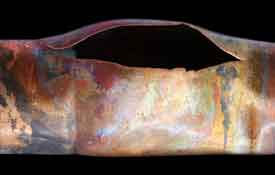 You would be surprised that a single burst pipe can trigger significant water damage in a home or company. Cold water pipelines are linked to the city water supply pressure, and if a pipe splits then high pressure water can quickly flood an enclosed location.
You would be surprised that a single burst pipe can trigger significant water damage in a home or company. Cold water pipelines are linked to the city water supply pressure, and if a pipe splits then high pressure water can quickly flood an enclosed location.
Frozen Pipelines
In areas like our own in Philadelphia, winters bring freezing weather, often accompanied by snow and ice. If a water line of length of pipeline consists of trapped water, then it is at risk from freezing as the temperature drops below zero. Many pipes have insulation covers to help prevent freezing, but in some cases an area of pipeline might be exposed to temperatures below freezing. Often un-insulated pipelines lie in an attic or basement, which may not be heated as well as the rest the building. Approximately 37 % of all frozen pipe failures take place in a basement. If a home or business owner is far from the home for a while, the burst may be unnoticed for a period of time, and it does not take long before a split water line discharges hundreds of gallons of water.
Considering that the area of a vulnerable water line is frequently out of sight, the initial damage might not be seen. If a pipe bursts in the attic or basement, it might be some time before you observe and then the first you understand is when a bulge appears in a ceiling or water is inches deep in the basement. The portion of water loss from a badly burst pipeline in your home can be over 105 gallons per hour. This means if you were away for a full twenty four hours you could have around 2,500 gallons of water in your house from a burst pipe.
Why makes a frozen pipe burst?
The physics behind a burst pipe is down to the properties of water. Sounds simple, but really water is a not a typical fluid. Like most things, liquids expand when warmed and shrink when cooled, however water has some truly distinct characteristics. As you would anticipate, water contracts as it cools off from space temperature to just above freezing (39 degrees F), but then, unlike other substances it starts an expansion. Exactly what happens is that the water particles (WATER) form themselves into a hexagonal crystal structure, which takes up more area than if the particles were simply at random. Frozen water expands by about 10% more than when in liquid type.
So when standing water is caught in a water line, then when it ices up, it will expand by almost ten per cent. If the water is caught, say be a faucet at one end and a valve at the other, then the only method for it to expand is inside the pipe, and typically the ice will split a pipeline run, or crack through a soldered joint. Ice can extend a way outside a pipeline, and might be unnoticed. When the temperature warms up, the ice melts, and water gushes out of the split.
What Do I do if a Pipe has Burst?
If there has actually been many gallons of water gushing from a water line, then professional water mitigation and specialists with specialized drying equipment might be needed. An expert restoration company like Restoration Aces can remove the water, and perform structural drying to ensure that mold growth does not happen, and your house is restored to its former glory.

